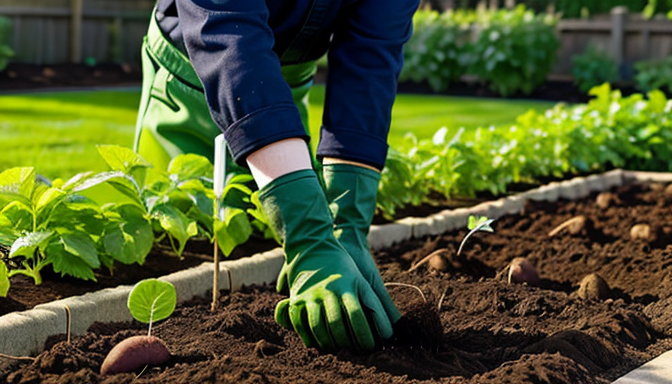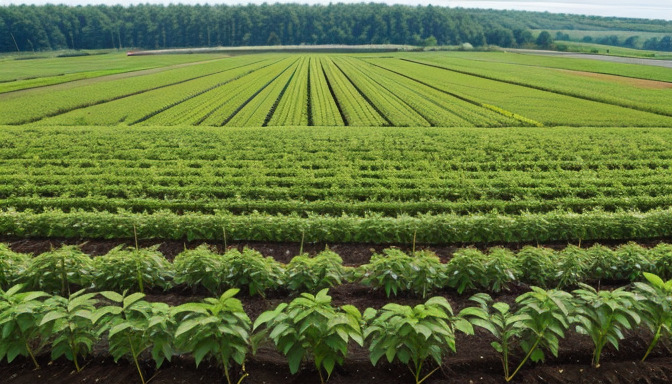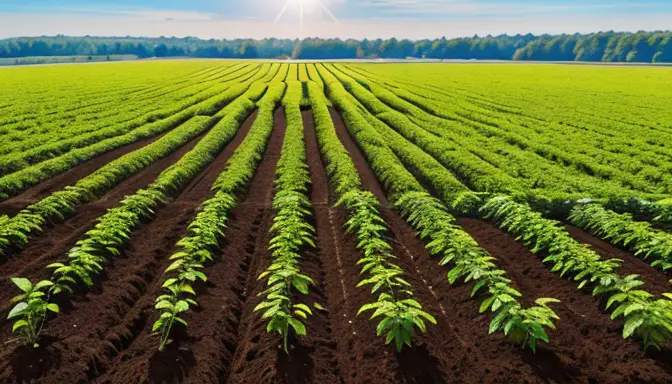This comprehensive guide provides step-by-step instructions on planting potatoes in Pennsylvania, including soil preparation, planting techniques, pest management, and harvesting tips.


Choosing the Right Potato Varieties
When it comes to choosing the right potato varieties for planting in Pennsylvania, several factors need to be considered to ensure a successful harvest. The diverse climate and soil conditions in Pennsylvania offer a range of options for potato growers. Here are some key points to keep in mind:
- Growing Conditions: Evaluate the growing conditions in your specific area of Pennsylvania, considering factors such as sunlight exposure, temperature fluctuations, and soil type.
- Intended Use: Determine whether you plan to use the potatoes for fresh consumption, processing, or storage, as different varieties are better suited for each purpose.
- Resistance: Look for varieties that are resistant to common potato diseases prevalent in Pennsylvania, such as late blight or potato scab, to ensure a healthy crop.
- Flavor and Texture: Consider the flavor profile and texture preferences you have for potatoes, whether you prefer a waxy or starchy variety for cooking.
- Yield: Some potato varieties have higher yields than others, so assess your space and harvesting goals to select a variety that meets your production needs.
By carefully considering these factors and conducting research on the various potato varieties available, you can choose the right ones that align with your preferences and growing conditions in Pennsylvania.

Preparing the Soil
When it comes to planting potatoes in Pennsylvania, preparing the soil is a critical step that sets the foundation for a successful harvest. To ensure optimal growth and yield, several key factors need to be considered in soil preparation:
- Testing pH Levels: Before planting, it’s essential to test the pH levels of the soil. Potatoes prefer slightly acidic soil with a pH range of 5.0 to 6.0.
- Improving Drainage: Proper drainage is crucial to prevent waterlogging, which can lead to rot and disease. Adding organic matter like compost can help improve soil structure and drainage.
- Adding Organic Matter: Incorporating organic matter such as compost or well-rotted manure can enhance soil fertility, promote beneficial soil organisms, and provide essential nutrients for potato growth.
By addressing these aspects of soil preparation, you can create an ideal environment for planting potatoes in Pennsylvania and set the stage for a bountiful harvest.

Planting Techniques
When it comes to planting potatoes in Pennsylvania, mastering the right planting techniques is key to a successful harvest. Whether you opt for hilling, trenching, or using seed potatoes, each method plays a crucial role in ensuring optimal growth and yield for your potato crop. By understanding the nuances of each technique, you can tailor your approach to suit the specific needs of your potato varieties and growing conditions. Additionally, considering factors like soil quality, spacing, and depth of planting can significantly impact the outcome of your potato harvest. Let’s delve into the various planting techniques to help you kickstart your potato cultivation journey in Pennsylvania.

Watering and Fertilizing
When it comes to your potato plants in Pennsylvania, precision is key. Potatoes require consistent moisture levels to thrive, so it’s crucial to water them regularly, especially during dry spells. However, overwatering can lead to rot and disease, so finding the right balance is essential. Additionally, fertilizing your potato plants is vital for healthy growth and a bountiful harvest. By providing the right nutrients at the right time, you can ensure robust plants and high yields.
To help you navigate the watering and fertilizing process effectively, consider the following tips:
- Watering: Use a soaker hose or drip irrigation system to deliver water directly to the soil, avoiding wetting the foliage which can promote disease. Water deeply and infrequently to encourage deep root growth.
- Fertilizing: Before planting, incorporate organic matter such as compost into the soil to provide a nutrient-rich foundation. During the growing season, consider using a balanced fertilizer to support healthy plant development.
- Monitoring: Keep an eye on your plants for signs of nutrient deficiencies or overwatering. Adjust your watering and fertilizing practices accordingly to meet the specific needs of your potato crop.

Pest and Disease Management
When it comes to pest and disease management in potato cultivation in Pennsylvania, being proactive is key to ensuring a healthy and abundant harvest. By identifying potential threats early on and implementing effective control measures, you can protect your potato crop from significant damage. Here are some essential tips for managing pests and diseases:
- Common Potato Pests: Keep an eye out for pests such as Colorado potato beetles, aphids, and potato leafhoppers that can quickly infest your potato plants.
- Early Detection: Regularly inspect your potato plants for any signs of pest infestation or disease symptoms, such as yellowing leaves or unusual spots.
- Preventive Measures: Implement cultural practices like crop rotation, proper spacing, and removing plant debris to reduce the risk of pest and disease development.
- Organic Controls: Consider using natural predators, neem oil, or insecticidal soap as eco-friendly alternatives to chemical pesticides.
- Chemical Controls: If pest or disease pressure becomes severe, consult with local agricultural extension services for approved chemical control options.
Remember, a healthy potato plant is more resilient to pests and diseases, so maintaining optimal growing conditions and practicing good garden hygiene are essential components of effective pest and disease management in your Pennsylvania potato patch.

Harvesting and Storage
When it comes to harvesting and storing your potato harvest in Pennsylvania, timing is crucial. Potatoes should be harvested when the tops of the plants have died back, indicating that the tubers are mature and ready for digging. To ensure a successful harvest, follow these essential steps:
- Determining the Right Time to Harvest: Wait until the foliage turns yellow and begins to dry out before harvesting. This signals that the potatoes have reached their full size and are ready to be dug up.
- Proper Harvesting Techniques: Carefully dig up the potatoes using a garden fork or shovel, being cautious not to damage the tubers. Gently brush off excess soil and avoid exposing the potatoes to direct sunlight for an extended period.
- Curing, Storing, and Preserving: After harvesting, allow the potatoes to cure in a cool, dark, and well-ventilated area for about two weeks. This process helps the skins to set, prolonging their storage life. Store the cured potatoes in a cool, dry location, such as a root cellar or a dark pantry, to prevent sprouting and maintain freshness.

Seasonal Care and Crop Rotation
When it comes to seasonal care and crop rotation for growing potatoes in Pennsylvania, it’s essential to follow a systematic approach to ensure a bountiful harvest year after year. Just like tending to a garden is a labor of love, taking care of your potato crop requires dedication and attention to detail. Let’s delve into the key practices that can help you maintain soil health and prevent disease buildup:
- Mulching: Applying a layer of mulch around your potato plants can help retain moisture, suppress weeds, and regulate soil temperature. This protective barrier not only conserves water but also adds organic matter to the soil as it breaks down over time.
- Weeding: Regular weeding is crucial to prevent competing plants from stealing nutrients and sunlight from your potato crop. By keeping the growing area free from weeds, you allow your potatoes to thrive and reach their full potential.
- Crop Rotation: Rotating your potato crop with other plant families each season can help reduce the risk of disease and pest infestations. By alternating the location of your potatoes, you disrupt the life cycles of potential threats and maintain soil fertility.
By incorporating these seasonal care practices into your potato cultivation routine, you not only promote the health of your current crop but also set the stage for future success. Remember, a well-tended potato patch is like a carefully orchestrated symphony, with each element playing a vital role in creating a harmonious and fruitful outcome.
Frequently Asked Questions
- What are the best potato varieties to plant in Pennsylvania?
Choosing the right potato varieties depends on your preferences and growing conditions. Some popular options for Pennsylvania include Yukon Gold, Russet, and Kennebec.
- How often should I water my potato plants?
Potatoes require consistent moisture levels, so it’s essential to water them regularly, especially during dry periods. Aim to keep the soil evenly moist but not waterlogged.
- What are common pests and diseases that affect potato crops in Pennsylvania?
Common pests in Pennsylvania include Colorado potato beetles and potato leafhoppers, while diseases like late blight and early blight can also impact potato plants. Implementing proper pest management strategies is crucial to protect your crop.
- Unraveling the Mystery of Yellowing Snake Plants - May 16, 2024
- Troubleshooting Yellowing Citronella Plants - May 16, 2024
- Troubleshooting: Elephant Ear Plant Turning Yellow - May 16, 2024







